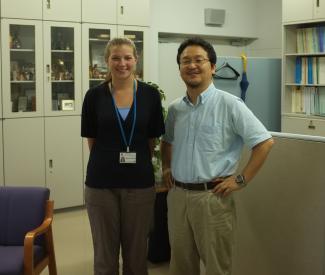Graduate student Jennifer Lubbeck (Jimenez Group) spent the summer of 2011 doing research in the Molecular Spectroscopy Laboratory at the RIKEN Institute in Wako, Japan (near Tokyo). Her host's group included 16 postdocs and four graduate students (Figure 1). The group was under the direction of Chief Scientist Tahei Tahara. However, Lubbeck actually worked directly with just five other young scientists under the supervision of Professor Kunihiko Ishi (Ishi-san).
“I was able to learn ultrafast techniques there that aren’t in use here at JILA,” Lubbeck says. “The experience helped me become a more well-rounded biophysics researcher.”
Lubbeck’s project was the study of the response of red fluorescent proteins to ultrafast laser light. Red fluorescent proteins are derived from sea anemones and coral. They have a barrel-shaped symmetric structure that surrounds and protects a color-producing entity (chromophore) that fluoresces red (Figure 2). Because developing a more stable red fluorescent protein is her thesis project, Lubbeck was able to overnight samples from the Jimenez lab to Riken for use in her summer project.
“At RIKEN, I primarily used spectroscopy to see which areas of the protein moved the most when the chromophore was excited by the laser,” Lubbeck said. “I was especially interested finding out if some red fluorescent proteins were more flexible than others, because increased flexibility of the part of the protein holding the chromophore could indicate a structural weakness.” In the process of learning to make careful measurements of time-dependent protein spectra, Lubbeck was also able to introduce some biophysics techniques to her lab mates.
“It was a good exchange,” Lubbeck reflects now on her 10-week summer program, which began with a week of orientation at the Sodenkai Institute in Hayama, Kanagawa prefecture. Her orientation included classes in Japanese language, musical instruments, and tea ceremony. At the end of orientation, she stayed with a local family, who introduced her to Karaoke and took her to see the sights of Kamakura.
After orientation, Lubbeck spent most of the next nine weeks working on her spectroscopy project at RIKEN. Her RIKEN colleagues did take her to a weeklong scientific conference (conducted in English) on the island of Hokkaido.
Back at RIKEN, Lubbeck was able to collect good data on her red fluorescent protein by working really hard, typically from 10 a.m. to 11 p.m. She describes her regular work schedule as like “JILA on steroids.” On days off and weekends, she took the opportunity to do some intense traveling in Japan (Figure 3).
Before leaving “early” at 6:00 p.m. one day to climb Mt. Fuji, for instance, she worked a “short” 10-hour day. After a two-hour bus ride, she got to the Mt. Fuji trailhead around 8:30 p.m. She hiked all night, arriving at the summit in time for the sunrise and amazing views. Then she hiked back down the mountain, caught the bus back to Wako, arriving at her apartment at noon. After sleeping until the next morning, she went back to work for a regular 15+ hour day.
“The experience was well worth it,” she says now. “I had the opportunity to see a hierarchical lab structure and learn how Japanese scientists run a laboratory. For instance, my boss Ishi-san decided everyday which one of us would get laser time. The labs at JILA have a much flatter structure.”
Back at JILA, Lubbeck is hard at work analyzing data from the summer research program. Her expenses for the program were paid by a grant from the U. S. National Science Foundation, with a contribution from the Japan Society for the Promotion of Science.



 The Physics Frontiers Centers (PFC) program supports university-based centers and institutes where the collective efforts of a larger group of individuals can enable transformational advances in the most promising research areas. The program is designed to foster major breakthroughs at the intellectual frontiers of physics by providing needed resources such as combinations of talents, skills, disciplines, and/or specialized infrastructure, not usually available to individual investigators or small groups, in an environment in which the collective efforts of the larger group can be shown to be seminal to promoting significant progress in the science and the education of students. PFCs also include creative, substantive activities aimed at enhancing education, broadening participation of traditionally underrepresented groups, and outreach to the scientific community and general public.
The Physics Frontiers Centers (PFC) program supports university-based centers and institutes where the collective efforts of a larger group of individuals can enable transformational advances in the most promising research areas. The program is designed to foster major breakthroughs at the intellectual frontiers of physics by providing needed resources such as combinations of talents, skills, disciplines, and/or specialized infrastructure, not usually available to individual investigators or small groups, in an environment in which the collective efforts of the larger group can be shown to be seminal to promoting significant progress in the science and the education of students. PFCs also include creative, substantive activities aimed at enhancing education, broadening participation of traditionally underrepresented groups, and outreach to the scientific community and general public.